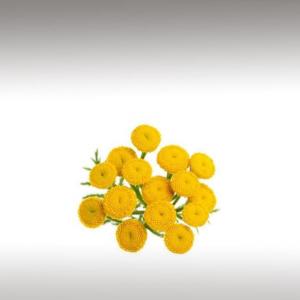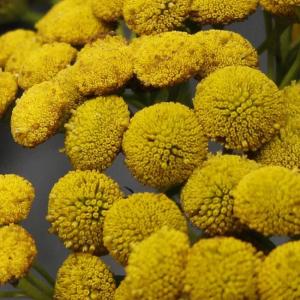
TANSY ESSENTIAL OIL (TANACETUM VULGARE) - ESSENTIAL OILS

BASE / GENERAL DATA
Information submited: August 12, 2016 Modified: March 22, 2018 By: OperaDreamhouse
Botanical Name: Tanacetum vulgare.
Botanical Origin: Europe and Asia.
Common Method of Extraction: Steam distillation.
Part Typically Used: Flowers / buds and sometimes leaves.
Color: Yellow to dark orange.
Consistency: Medium.
Perfumery Note: Middle.
Shelf Life: 1-2 years.
Strength of Initial Aroma: Highly aromatic, warm, bitter-sweet, herbaceous aroma with softly penetrating camphor top notes. Sweet, fruity, with subtle floral, camphorous undertones.
Blends Well With: Amyris, Angelica, Bergamot, Cedarwood, Cistus, Clary Sage, Frankincense, Geranium, Jasmine, Labdanum, Lavender, Lemon, Marjoram, Neroli, Palmarosa, Patchouli, Rose, Sandalwood, Ylang-Ylang essential oils.
Common name : Common Tansy, Bitter Buttons, Cow Bitter, Golden Buttons.
Chemical structure: Ketone. Up to 80% thujone, camphor, borneol, artemisia ketone.
Note: Tansy essential oil (Tanacetum Vulgare) and Blue Tansy essential oil (Tanacetum Annuum) are very different in their chemical make-up, and subsequent use, despite the fact that they both belong to the Asteraceae plant family. Tanacetum Annuum is often confused with common Tansy (Tanacetum Vulgare) but the former produces an essential oil that is completely different chemically as it contains no thujone and high amounts of chamazulene making the oil dark blue in color, giving rise to it common name of Blue Tansy oil.
Despite claims by some unethical resellers of essential oils who adulterate the very expensive Blue Tansy (Tanacetum Annuum) oil with the much cheaper oil from Tanacetum Vulgare, it should be noted that the oil from Tanacetum Vulgare is never blue in color as it contains no chamazulene. For this reason a high thujone oil from Tanacetum Vulgare should never be referred to as "Blue Tansy" oil and any such blue oil containing significant thujone is an adulterated product.
Botanical Origin: Europe and Asia.
Common Method of Extraction: Steam distillation.
Part Typically Used: Flowers / buds and sometimes leaves.
Color: Yellow to dark orange.
Consistency: Medium.
Perfumery Note: Middle.
Shelf Life: 1-2 years.
Strength of Initial Aroma: Highly aromatic, warm, bitter-sweet, herbaceous aroma with softly penetrating camphor top notes. Sweet, fruity, with subtle floral, camphorous undertones.
Blends Well With: Amyris, Angelica, Bergamot, Cedarwood, Cistus, Clary Sage, Frankincense, Geranium, Jasmine, Labdanum, Lavender, Lemon, Marjoram, Neroli, Palmarosa, Patchouli, Rose, Sandalwood, Ylang-Ylang essential oils.
Common name : Common Tansy, Bitter Buttons, Cow Bitter, Golden Buttons.
Chemical structure: Ketone. Up to 80% thujone, camphor, borneol, artemisia ketone.
Note: Tansy essential oil (Tanacetum Vulgare) and Blue Tansy essential oil (Tanacetum Annuum) are very different in their chemical make-up, and subsequent use, despite the fact that they both belong to the Asteraceae plant family. Tanacetum Annuum is often confused with common Tansy (Tanacetum Vulgare) but the former produces an essential oil that is completely different chemically as it contains no thujone and high amounts of chamazulene making the oil dark blue in color, giving rise to it common name of Blue Tansy oil.
Despite claims by some unethical resellers of essential oils who adulterate the very expensive Blue Tansy (Tanacetum Annuum) oil with the much cheaper oil from Tanacetum Vulgare, it should be noted that the oil from Tanacetum Vulgare is never blue in color as it contains no chamazulene. For this reason a high thujone oil from Tanacetum Vulgare should never be referred to as "Blue Tansy" oil and any such blue oil containing significant thujone is an adulterated product.
Tansy is native to Eurasia. It is found in almost all parts of mainland Europe, as well as Britain and Ireland. It is absent from Siberia and some of the Mediterranean islands. The Ancient Greeks may have been the first to cultivate it as a medicinal herb.
Tansy is a flowering herbaceous plant with finely divided compound leaves and yellow, button-like flowers. It has a stout, somewhat reddish, erect stem, usually smooth, 50 - 150 cm tall. The roundish, flat - topped, button - like, yellow flower heads are produced in terminal clusters from mid - to - late summer.
The scent is similar to that of camphor with hints of Rosemary. The leaves and flowers are toxic if consumed in large quantities; the volatile oil contains toxic compounds including thujone, which can cause convulsions and liver and brain damage. Some insects, notably the Tansy beetle Chrysolina Graminis, have resistance to the toxins and subsist almost exclusively on the plant.
Tanacetum Vulgare belongs to the Asteraceae plant family.
The name is said to be a corruption of "Athanasia", derived from two Greek words meaning immortality.
When some monks in reading Lucian came across the passage where Jove, speaking of Ganymede to Mercury, says, "Take him hence, and when he has tasted immortality let him return to us," their literal minds inferred that this plant must have been what Ganymede tasted, hence they named it Athanasia.
So great credence having been given to its medicinal powers in Europe, it is not strange the colonists felt they could not live in the New World without Tansy. Strong scented pungent tufts topped with bright yellow buttons - runaways from old gardens - are a conspicuous feature along many a roadside leading to colonial homesteads.
Tansy was hung on the house by Germanic peoples as a protection against monsters. The aromatic herb was also burned as incense.
Tansy is a flowering herbaceous plant with finely divided compound leaves and yellow, button-like flowers. It has a stout, somewhat reddish, erect stem, usually smooth, 50 - 150 cm tall. The roundish, flat - topped, button - like, yellow flower heads are produced in terminal clusters from mid - to - late summer.
The scent is similar to that of camphor with hints of Rosemary. The leaves and flowers are toxic if consumed in large quantities; the volatile oil contains toxic compounds including thujone, which can cause convulsions and liver and brain damage. Some insects, notably the Tansy beetle Chrysolina Graminis, have resistance to the toxins and subsist almost exclusively on the plant.
Tanacetum Vulgare belongs to the Asteraceae plant family.
The name is said to be a corruption of "Athanasia", derived from two Greek words meaning immortality.
When some monks in reading Lucian came across the passage where Jove, speaking of Ganymede to Mercury, says, "Take him hence, and when he has tasted immortality let him return to us," their literal minds inferred that this plant must have been what Ganymede tasted, hence they named it Athanasia.
So great credence having been given to its medicinal powers in Europe, it is not strange the colonists felt they could not live in the New World without Tansy. Strong scented pungent tufts topped with bright yellow buttons - runaways from old gardens - are a conspicuous feature along many a roadside leading to colonial homesteads.
Tansy was hung on the house by Germanic peoples as a protection against monsters. The aromatic herb was also burned as incense.

SPIRITUAL PRACTISES DATA
Information submited: August 12, 2016 Modified: March 22, 2018 By: OperaDreamhouse
Element Association: Yang
Emotional Attributes: Can indicate that you have done very good work and are now ready to take your place within a seat of power. Tansy is a very powerful agent. Do not use without spiritual guidance.
Emotional Attributes: Can indicate that you have done very good work and are now ready to take your place within a seat of power. Tansy is a very powerful agent. Do not use without spiritual guidance.

MEDICINE / HEALTH DATA
Information submited: August 12, 2016 Modified: March 22, 2018 By: OperaDreamhouse
Therapeutic Properties :
Antibacterial
Anti-fungal
Anti-inflammatory
Anti-histaminic
Antiviral
Febrifuge
Insecticide
Hormone stimulant
Sedative
Contraindications: No aromatherapy application. Contact dermatitis in sensitive individuals. Oral toxin, hazardous, irritant, sensitizer, neuron-toxic, avoid in epilepsy.
Antibacterial
Anti-fungal
Anti-inflammatory
Anti-histaminic
Antiviral
Febrifuge
Insecticide
Hormone stimulant
Sedative
Contraindications: No aromatherapy application. Contact dermatitis in sensitive individuals. Oral toxin, hazardous, irritant, sensitizer, neuron-toxic, avoid in epilepsy.
Pregnancy / Lactation: Abortive. Do not use in pregnancy or nursing period.
Children: 10-12 years.
Tansy essential oil has a warm, spicy - herbaceous aroma. The principal chemical component in Tansy essential oil is thujone, a fairly “reactive” component. Lawless lists tansy as “abortifacient” and advises against use of the essential oil for therapeutic aromatherapy practice.
The danger with using Tansy rests primarily with it's thujone content, which is responsible for much of tansy's medicinal actions. Thujone is powerful but toxic in large doses. The amount of thujone contained can vary from plant to plant making safe dosing problematic.
Tansy essential oil is anticatarrh, anthelmintic (powerfulexpectorant, mucolytic, carminative, nervine stimulant, tonic. Used for congestion, repel insects and fleas, intestinal worms.
Tansy has a long history of use. It was first recorded as being cultivated by the ancient Greeks for medicinal purposes. In the 8th century AD it was grown in the herb gardens of Charlemagne and by Benedictine monks of the Swiss monastery of Saint Gall. Tansy was used to treat intestinal worms, rheumatism, digestive problems, fevers, sores, and to “bring out” measles.
During the Middle Ages and later, high doses were used to induce abortions. Contradictorily, Tansy was also used to help women conceive and to prevent miscarriages.
It was used in Europe to treat hysterical women who were unable to menstruate regularly and it was also used as an abortive. A bitter tea was made for a woman's tonic. Gypsies considered the plant a "Cure all."
In the 19th century, Irish folklore suggested that bathing in a solution of Tansy and salts would cure joint pain. Although most of its medicinal uses have been discredited, Tansy is still a component of some medicines and is listed in Pharmacopeia as a treatment for fevers, feverish colds, and jaundice.
It should not be very hard to understand that the essential oil, which is so poisonous and can be fatal to humans, would also be deadly for those tiny bacteria. Although some bacteriacan survive unimaginable extremities of temperature and toxins, for most of the bacteria which live in the human body, this oil is lethal. It kills them and inhibits their multiplication. This gives effective protection against bacterial infections, provided that it is taken in very, very mild doses.
Tansy was also used to alleviate the pain of for migraine headaches, neuralgia, rheumatism and gout, meteorism (distended stomach due to trapped gas), and loss of appetite.
This oil acts as a sedative for nerves and emotional impulses. In cases of anxiety, depression, anger, convulsions, nervous afflictions, epilepsy, hysteric attacks, and impulsive behavior, it can be used to pacify them and induce a relaxing effect on the nerves and the brain.

BEAUTY / COSMETICS DATA
Information submited: September 10, 2016 Modified: February 19, 2018 By: OperaDreamhouse
Tansy was used as a face wash and was reported to lighten and purify the skin.

FOOD / COOKING DATA
COMMENTS
No comments.



